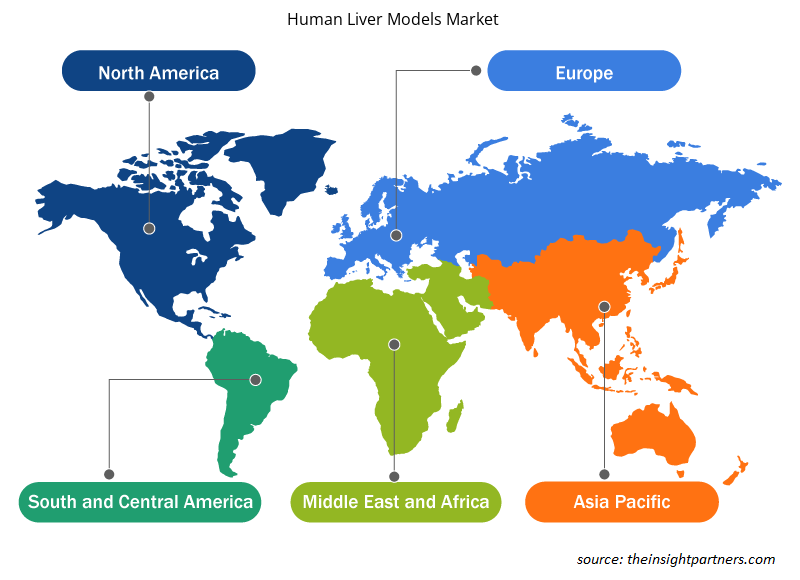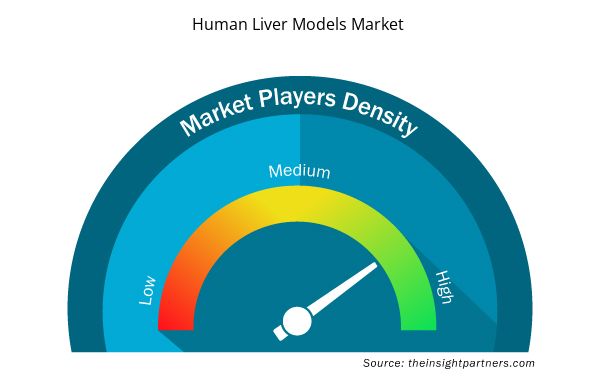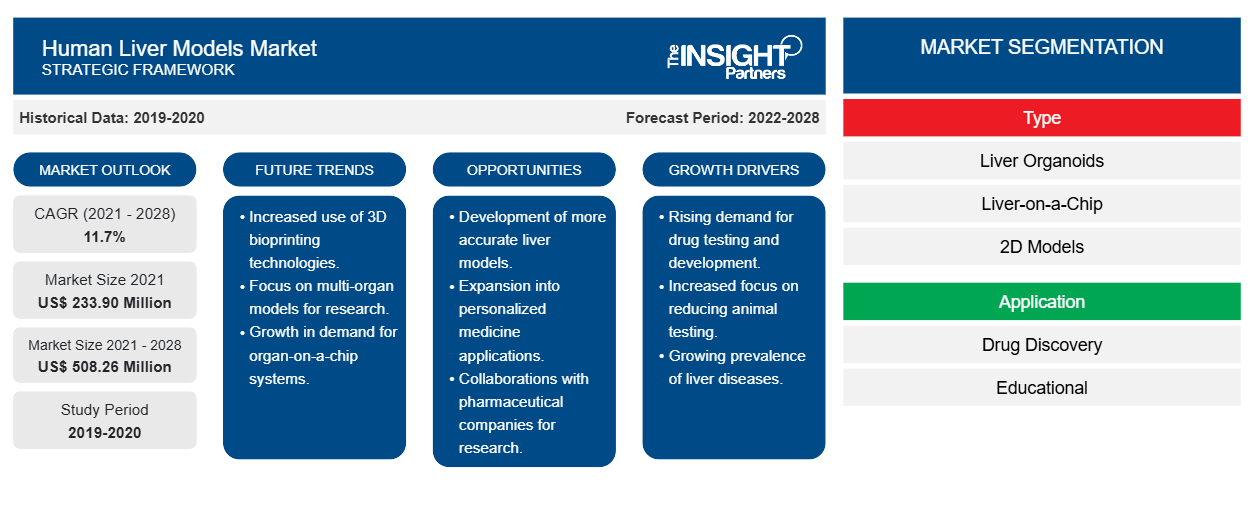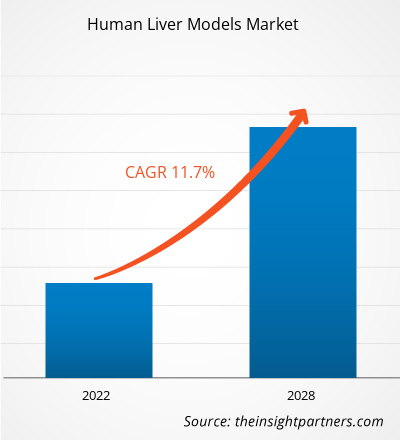Der Markt für menschliche Lebermodelle soll von 233,90 Millionen US-Dollar im Jahr 2021 auf 508,26 Millionen US-Dollar im Jahr 2028 anwachsen; von 2021 bis 2028 dürfte er voraussichtlich mit einer durchschnittlichen jährlichen Wachstumsrate von 11,7 % wachsen.CAGR of 11.7% from 2021 to 2028.
Das Wachstum des Marktes ist in erster Linie auf die zunehmende Verbreitung von Lebererkrankungen und den wachsenden Fokus auf die Entwicklung von Alternativen zu Tierversuchsmodellen zurückzuführen. Die hohen Kosten für menschliche Lebermodelle und Probleme bei der Einbindung von Lebermodellen in bestehende Arbeitsabläufe behindern jedoch das Wachstum des Marktes für menschliche Lebermodelle . Die Leber ist ein wichtiges Organ, das lebenswichtige Körperfunktionen wie die Synthese von Blutgerinnungsfaktoren, die Gallenproduktion, die Proteinproduktion und die Entgiftung erfüllt. Menschliche Lebermodelle werden verwendet, um die Toxizität von Medikamenten zu untersuchen und die Wirkung von Medikamenten und den Verlauf von Lebererkrankungen zu verstehen. Der zunehmende Fokus auf die Entwicklung von Alternativen zu Tierversuchsmodellen ist einer der Hauptfaktoren, die das Wachstum der globalen menschlichen Lebermodelle in den nächsten Jahren fördern dürften.
Aufgrund des COVID-19-Ausbruchs war die biopharmazeutische Industrie im asiatisch-pazifischen Raum im Jahr 2020 einige Monate lang gestört. Die COVID-19-Pandemie hat klinische Studien in beispielloser Weise beeinträchtigt, da zur Eindämmung der Infektionsausbreitung zahlreiche Einschränkungen verhängt wurden. Angesichts der steigenden Nachfrage nach Produkten zur Behandlung der COVID-19-Infektion haben die biopharmazeutischen und pharmazeutischen Unternehmen in Indien und China jedoch ihre Forschungsaktivitäten verstärkt, was sich positiv auf das Marktwachstum auswirkt.
Passen Sie diesen Bericht Ihren Anforderungen an
Sie erhalten kostenlose Anpassungen an jedem Bericht, einschließlich Teilen dieses Berichts oder einer Analyse auf Länderebene, eines Excel-Datenpakets sowie tolle Angebote und Rabatte für Start-ups und Universitäten.
- Holen Sie sich die wichtigsten Markttrends aus diesem Bericht.Dieses KOSTENLOSE Beispiel umfasst eine Datenanalyse von Markttrends bis hin zu Schätzungen und Prognosen.
Markteinblicke
Zunehmende Prävalenz von Lebererkrankungen treibt Marktwachstum bei menschlichen Lebermodellen voran
Die Leber ist das größte innere Organ des menschlichen Körpers und erfüllt über 500 Funktionen. Lebertoxizität ist ein großes Problem bei der Risikobewertung, da die Leber den meisten xenobiotischen Verbindungen und ihren bioaktiven Metaboliten ausgesetzt ist und dadurch anfällig für chemisch bedingte Lebererkrankungen ist. Zu den Hauptursachen für chronische Lebererkrankungen zählen das Hepatitis-C-Virus (HCV), das chronische Hepatitis-B-Virus (HBV), die nichtalkoholische Fettlebererkrankung (NAFLD) und die alkoholbedingte Lebererkrankung (ALD). Virushepatitis ist nach wie vor die häufigste Todesursache durch Leberversagen, und gleichzeitig ist die NAFLD zu einer der am schnellsten wachsenden Ursachen für Lebererkrankungen und die damit verbundene Mortalität geworden. Laut der nationalen Statistik des Vereinigten Königreichs sind Lebererkrankungen die fünfthäufigste Todesursache im Land.xenobiotic compounds and their bioactive metabolites, making it susceptible to chemically induced liver disease. Hepatitis C virus (HCV), chronic hepatitis B virus (HBV), nonalcoholic fatty liver disease (NAFLD), and alcohol-associated liver disease (ALD) are among the leading causes of chronic liver disease. Viral hepatitis continues to be the leading cause of death cases caused by liver failure, and at the same time, the NAFLD has become one of the fastest-growing contributors to liver morbidity and associated mortality. According to the national statistics of the UK, liver diseases have been ranked the fifth-leading cause of death in the country.
Darüber hinaus gelten diese Krankheiten in den USA als zweithäufigste Todesursache unter allen Verdauungskrankheiten. Laut der American Association for the Study of Liver Diseases ist die globale Belastung durch Leberkrebs und Leberzirrhose im Jahr 2017 gestiegen. NAFLDs haben eine geschätzte Prävalenz von ~25 % in der Allgemeinbevölkerung. Fast ein Drittel der US-Bevölkerung hat NAFLD, und Menschen mit Typ-2-Diabetes mellitus oder Fettleibigkeit sind überproportional betroffen; die Zahl der NAFLD-Fälle wird voraussichtlich von 83,1 Millionen Menschen im Jahr 2015 auf 100,9 Millionen bis 2030 steigen. Ein Anstieg der globalen Prävalenz von Lebererkrankungen, einschließlich chronischer und akuter Erkrankungen und mikrobieller Infektionen, erhöht also die Nachfrage nach Lebermodellen.NAFLDs have an estimated prevalence of ~25% in the general population. Nearly a third of the US population has the NAFLD, and people with Type 2 diabetes mellitus or obesity are disproportionately affected; the number of cases with NAFLD is expected to increase from 83.1 million people in 2015 to 100.9 million by 2030. Thus, a rise in the global prevalence of liver diseases, including chronic and acute diseases and microbial infections, increases the demand for liver models.
Typbasierte Erkenntnisse
Basierend auf dem Typ ist der Markt für menschliche Lebermodelle weiter segmentiert in Leberorganoide, Leber-auf-einem-Chip, 2D-Modelle, 3D-Bioprinting und andere. Das Segment der Leberorganoide hält den größten Marktanteil. Es wird jedoch erwartet, dass das Segment Leber-auf-einem-Chip zwischen 2021 und 2028 die höchste durchschnittliche jährliche Wachstumsrate verzeichnet. Fortschritte in der Leberorganoid-Technologie liefern Modelle für die pränatale Entwicklung, Gewebekonservierung und Pathologien, die das Marktwachstum dieses Segments in den kommenden Jahren vorantreiben werden.organoids, liver-on-a-chip, 2D models, 3D bioprinting, and others. The liver organoids segment holds the largest share of the market. However, the liver-on-a-chip segment is anticipated to register the highest CAGR during 2021–2028. Advances in liver organoid technology provide models for prenatal development, tissue preservation, and pathologies, which would propel the market growth of this segment in the coming years.
Anwendungsbasierte Erkenntnisse
Basierend auf der Anwendung wird der Markt für menschliche Lebermodelle weiter in die Bereiche Bildung, Arzneimittelforschung und Sonstige unterteilt. Das Segment Arzneimittelforschung hält den größten Anteil am Markt für menschliche Lebermodelle; es wird jedoch erwartet, dass das Bildungssegment im Prognosezeitraum die höchste durchschnittliche jährliche Wachstumsrate verzeichnet.CAGR during the forecast period.
Endbenutzerbasierte Erkenntnisse
Basierend auf dem Endverbraucher ist der Markt für menschliche Lebermodelle in Forschungsinstitute, Pharma- und Biotechnologieunternehmen und andere unterteilt. Das Segment der Pharma- und Biotechnologieunternehmen hält den größten Marktanteil. Es wird jedoch geschätzt, dass das Segment der Forschungsinstitute im Prognosezeitraum die höchste durchschnittliche jährliche Wachstumsrate verzeichnet. Das prognostizierte Marktwachstum für dieses Segment ist auf eine Zunahme der Zusammenarbeit zwischen Industrie und Universitäten bei der Genomforschung sowie auf technologische Fortschritte bei der Herstellung menschlicher Lebermodelle zurückzuführen.
Auf dem Markt für menschliche Lebermodelle tätige Unternehmen verfolgen eine Strategie der Produktinnovation, um die sich weltweit entwickelnde Kundennachfrage zu erfüllen und gleichzeitig ihren Markennamen auf dem Weltmarkt zu behaupten.
Regionale Einblicke in den Markt für menschliche Lebermodelle
Die regionalen Trends und Faktoren, die den Markt für menschliche Lebermodelle während des gesamten Prognosezeitraums beeinflussen, wurden von den Analysten von Insight Partners ausführlich erläutert. In diesem Abschnitt werden auch die Marktsegmente und die Geografie für menschliche Lebermodelle in Nordamerika, Europa, im asiatisch-pazifischen Raum, im Nahen Osten und Afrika sowie in Süd- und Mittelamerika erörtert.

- Erhalten Sie regionale Daten zum Markt für menschliche Lebermodelle
Umfang des Marktberichts zu menschlichen Lebermodellen
| Berichtsattribut | Details |
|---|---|
| Marktgröße im Jahr 2021 | 233,90 Millionen US-Dollar |
| Marktgröße bis 2028 | 508,26 Millionen US-Dollar |
| Globale CAGR (2021 - 2028) | 11,7 % |
| Historische Daten | 2019-2020 |
| Prognosezeitraum | 2022–2028 |
| Abgedeckte Segmente | Nach Typ
|
| Abgedeckte Regionen und Länder | Nordamerika
|
| Marktführer und wichtige Unternehmensprofile |
|
Marktteilnehmerdichte: Der Einfluss auf die Geschäftsdynamik
Der Markt für menschliche Lebermodelle wächst rasant, angetrieben durch die steigende Nachfrage der Endnutzer aufgrund von Faktoren wie sich entwickelnden Verbraucherpräferenzen, technologischen Fortschritten und einem größeren Bewusstsein für die Vorteile des Produkts. Mit steigender Nachfrage erweitern Unternehmen ihr Angebot, entwickeln Innovationen, um die Bedürfnisse der Verbraucher zu erfüllen, und nutzen neue Trends, was das Marktwachstum weiter ankurbelt.
Die Marktteilnehmerdichte bezieht sich auf die Verteilung der Firmen oder Unternehmen, die in einem bestimmten Markt oder einer bestimmten Branche tätig sind. Sie gibt an, wie viele Wettbewerber (Marktteilnehmer) in einem bestimmten Marktraum im Verhältnis zu seiner Größe oder seinem gesamten Marktwert präsent sind.
Die wichtigsten auf dem Markt für menschliche Lebermodelle tätigen Unternehmen sind:
- THERMO FISHER SCIENTIFIC INC.
- Emulate, Inc.
- CN Bio Innovations,
- CYFUSE BIOMEDICAL KK
- MIMETAS BV
Haftungsausschluss : Die oben aufgeführten Unternehmen sind nicht in einer bestimmten Reihenfolge aufgeführt.

- Überblick über die wichtigsten Akteure auf dem Markt für menschliche Lebermodelle
Markt für menschliche Lebermodelle – nach Typ
- Leber-Organoide
- Leber auf einem Chip
- 2D-Modelle
- 3D-Biodruck
- Sonstiges
Markt für menschliche Lebermodelle – nach Anwendung
- Arzneimittelforschung
- Lehrreich
- Andere
Markt für menschliche Lebermodelle – nach Endbenutzer
- Pharma- und Biotechnologieunternehmen
- Forschungsinstitute
- Sonstiges
Markt für menschliche Lebermodelle – nach Geografie
Nordamerika
- UNS
- Kanada
- Mexiko
Europa
- Frankreich
- Deutschland
- Italien
- Vereinigtes Königreich
- Spanien
- Restliches Europa
Asien-Pazifik (APAC)
- China
- Indien
- Südkorea
- Japan
- Australien
- Restlicher Asien-Pazifik-Raum
Naher Osten und Afrika (MEA)
- Südafrika
- Saudi-Arabien
- Vereinigte Arabische Emirate
- Rest von MEA
Süd- und Mittelamerika (SCAM)
- Brasilien
- Argentinien
- Rest von SCAM
Firmenprofile
- THERMO FISHER SCIENTIFIC INC.
- Emulate, Inc.
- CN Bio Innovations,
- CYFUSE BIOMEDICAL KK
- MIMETAS BV
- InSphero
- BioIVT
- CELLINK
- Kerafast
- Zypern
- Kirkstall
- ORGANOVO HOLDINGS INC
- Historische Analyse (2 Jahre), Basisjahr, Prognose (7 Jahre) mit CAGR
- PEST- und SWOT-Analyse
- Marktgröße Wert/Volumen – Global, Regional, Land
- Branche und Wettbewerbsumfeld
- Excel-Datensatz



Report Coverage
Revenue forecast, Company Analysis, Industry landscape, Growth factors, and Trends

Segment Covered
This text is related
to segments covered.

Regional Scope
North America, Europe, Asia Pacific, Middle East & Africa, South & Central America

Country Scope
This text is related
to country scope.
Häufig gestellte Fragen
The liver-on-a-chip segment is growing at the highest CAGR owing to increasing demand for cost-effective alternatives to animal models for drug research and development.
Asia Pacific is expected to be the fastest growing region in the Human Liver Models market. The growth of the market in this region is primarily due to growing biopharmaceutical industry, increasing number of clinical trials, and increasing research activities for the development of innovative therapies.
North America dominates the global human liver models market due to factors such as increasing incidences of the liver diseases such as cirrhosis, chronic liver disease (CLD), Nonalcoholic fatty liver disease (NAFLD) and others across the country. Moreover, the growth of market in Canada is expected to grow due to increasing support from the government to address the rising concerns about the liver diseases.
The factors that are driving growth of the market are increasing prevalence of liver diseases, and growing focus on developing alternatives for animal testing models.
Various companies have made organic growth strategies in the human liver models market. Some of the activities undertaken by the company, which have promoted its growth are, launches, enhancements and expansion & relocation activities. Companies such as InSphero, Emulate, Inc amongst others are some of the companies that have been implementing various organic strategies that have helped the growth of the company.
Trends and growth analysis reports related to Life Sciences : READ MORE..
The List of Companies - Human Liver Models Market
- THERMO FISHER SCIENTIFIC INC.
- Emulate, Inc.
- CN Bio Innovations,
- CYFUSE BIOMEDICAL K.K.
- MIMETAS BV
- InSphero
- BioIVT
- CELLINK
- Kerafast
- Cyprio
- Kirkstall
- ORGANOVO HOLDINGS INC
The Insight Partners performs research in 4 major stages: Data Collection & Secondary Research, Primary Research, Data Analysis and Data Triangulation & Final Review.
- Data Collection and Secondary Research:
As a market research and consulting firm operating from a decade, we have published and advised several client across the globe. First step for any study will start with an assessment of currently available data and insights from existing reports. Further, historical and current market information is collected from Investor Presentations, Annual Reports, SEC Filings, etc., and other information related to company’s performance and market positioning are gathered from Paid Databases (Factiva, Hoovers, and Reuters) and various other publications available in public domain.
Several associations trade associates, technical forums, institutes, societies and organization are accessed to gain technical as well as market related insights through their publications such as research papers, blogs and press releases related to the studies are referred to get cues about the market. Further, white papers, journals, magazines, and other news articles published in last 3 years are scrutinized and analyzed to understand the current market trends.
- Primary Research:
The primarily interview analysis comprise of data obtained from industry participants interview and answers to survey questions gathered by in-house primary team.
For primary research, interviews are conducted with industry experts/CEOs/Marketing Managers/VPs/Subject Matter Experts from both demand and supply side to get a 360-degree view of the market. The primary team conducts several interviews based on the complexity of the markets to understand the various market trends and dynamics which makes research more credible and precise.
A typical research interview fulfils the following functions:
- Provides first-hand information on the market size, market trends, growth trends, competitive landscape, and outlook
- Validates and strengthens in-house secondary research findings
- Develops the analysis team’s expertise and market understanding
Primary research involves email interactions and telephone interviews for each market, category, segment, and sub-segment across geographies. The participants who typically take part in such a process include, but are not limited to:
- Industry participants: VPs, business development managers, market intelligence managers and national sales managers
- Outside experts: Valuation experts, research analysts and key opinion leaders specializing in the electronics and semiconductor industry.
Below is the breakup of our primary respondents by company, designation, and region:

Once we receive the confirmation from primary research sources or primary respondents, we finalize the base year market estimation and forecast the data as per the macroeconomic and microeconomic factors assessed during data collection.
- Data Analysis:
Once data is validated through both secondary as well as primary respondents, we finalize the market estimations by hypothesis formulation and factor analysis at regional and country level.
- Macro-Economic Factor Analysis:
We analyse macroeconomic indicators such the gross domestic product (GDP), increase in the demand for goods and services across industries, technological advancement, regional economic growth, governmental policies, the influence of COVID-19, PEST analysis, and other aspects. This analysis aids in setting benchmarks for various nations/regions and approximating market splits. Additionally, the general trend of the aforementioned components aid in determining the market's development possibilities.
- Country Level Data:
Various factors that are especially aligned to the country are taken into account to determine the market size for a certain area and country, including the presence of vendors, such as headquarters and offices, the country's GDP, demand patterns, and industry growth. To comprehend the market dynamics for the nation, a number of growth variables, inhibitors, application areas, and current market trends are researched. The aforementioned elements aid in determining the country's overall market's growth potential.
- Company Profile:
The “Table of Contents” is formulated by listing and analyzing more than 25 - 30 companies operating in the market ecosystem across geographies. However, we profile only 10 companies as a standard practice in our syndicate reports. These 10 companies comprise leading, emerging, and regional players. Nonetheless, our analysis is not restricted to the 10 listed companies, we also analyze other companies present in the market to develop a holistic view and understand the prevailing trends. The “Company Profiles” section in the report covers key facts, business description, products & services, financial information, SWOT analysis, and key developments. The financial information presented is extracted from the annual reports and official documents of the publicly listed companies. Upon collecting the information for the sections of respective companies, we verify them via various primary sources and then compile the data in respective company profiles. The company level information helps us in deriving the base number as well as in forecasting the market size.
- Developing Base Number:
Aggregation of sales statistics (2020-2022) and macro-economic factor, and other secondary and primary research insights are utilized to arrive at base number and related market shares for 2022. The data gaps are identified in this step and relevant market data is analyzed, collected from paid primary interviews or databases. On finalizing the base year market size, forecasts are developed on the basis of macro-economic, industry and market growth factors and company level analysis.
- Data Triangulation and Final Review:
The market findings and base year market size calculations are validated from supply as well as demand side. Demand side validations are based on macro-economic factor analysis and benchmarks for respective regions and countries. In case of supply side validations, revenues of major companies are estimated (in case not available) based on industry benchmark, approximate number of employees, product portfolio, and primary interviews revenues are gathered. Further revenue from target product/service segment is assessed to avoid overshooting of market statistics. In case of heavy deviations between supply and demand side values, all thes steps are repeated to achieve synchronization.
We follow an iterative model, wherein we share our research findings with Subject Matter Experts (SME’s) and Key Opinion Leaders (KOLs) until consensus view of the market is not formulated – this model negates any drastic deviation in the opinions of experts. Only validated and universally acceptable research findings are quoted in our reports.
We have important check points that we use to validate our research findings – which we call – data triangulation, where we validate the information, we generate from secondary sources with primary interviews and then we re-validate with our internal data bases and Subject matter experts. This comprehensive model enables us to deliver high quality, reliable data in shortest possible time.


 Holen Sie sich ein kostenloses Muster für diesen Bericht
Holen Sie sich ein kostenloses Muster für diesen Bericht